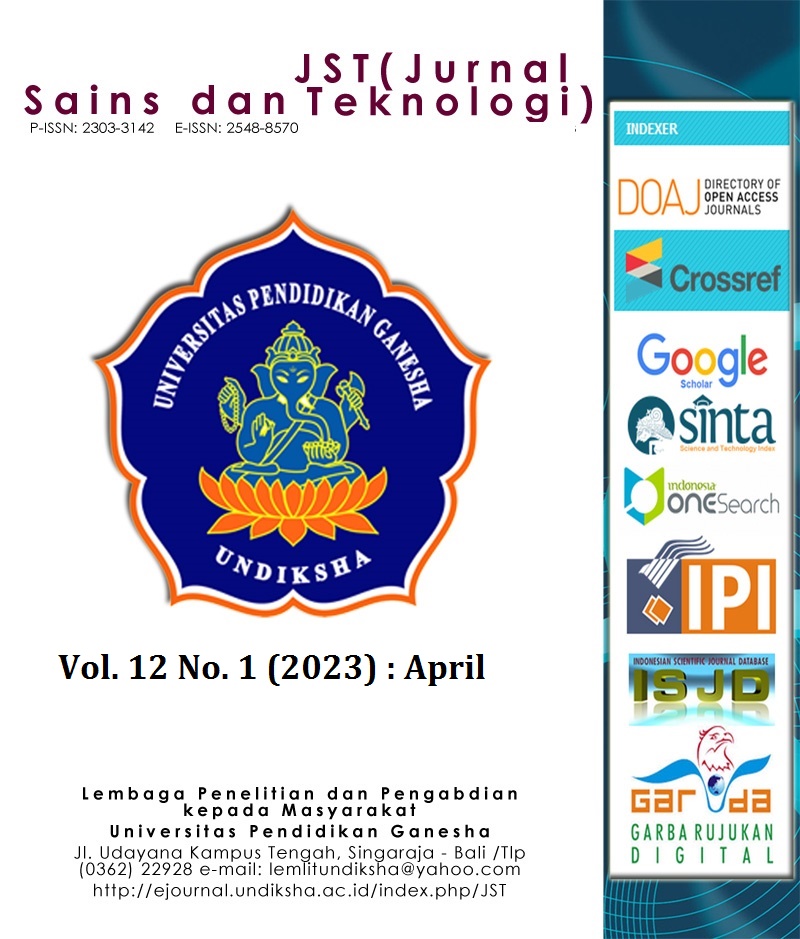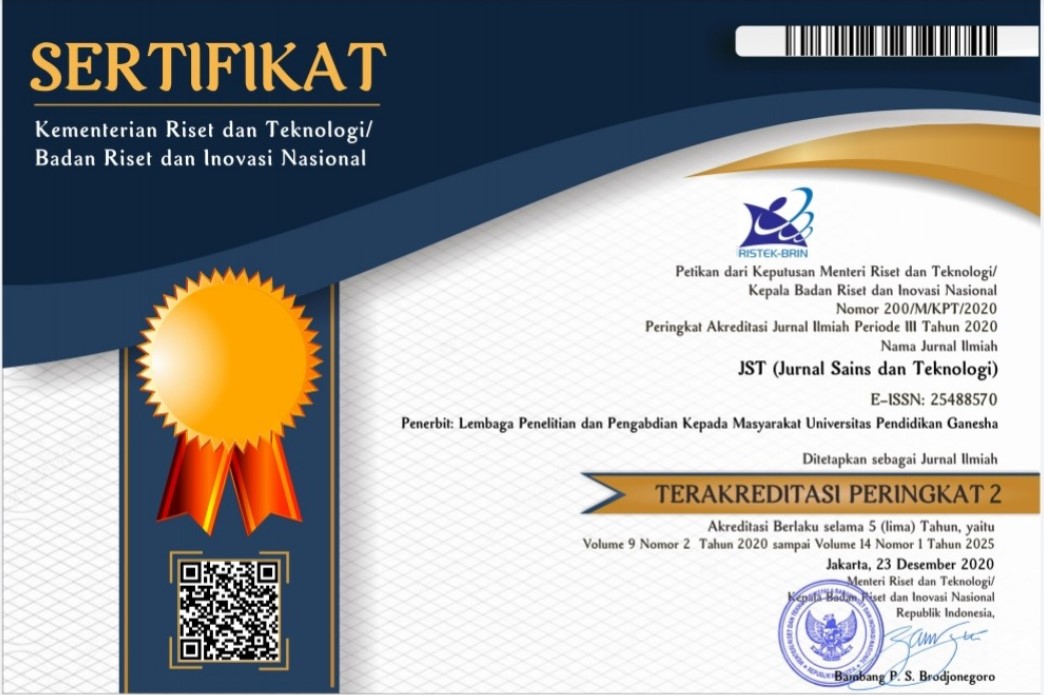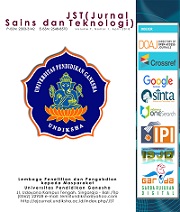Chromophoric Dissolved Organic Matter (CDOM) and Dissolved Nutrients in Water Sources in North Bali
DOI:
https://doi.org/10.23887/jstundiksha.v12i1.59811Keywords:
spring water, rainfall, chromophoric dissolved organic matter, dissolved nutrientsAbstract
The objective of this study was to determine the absorbance of chromophoric dissolved organic matter (CDOM) and dissolved nutrient concentration in a spring water located at Sanggalangit, Kecamatan Gerokgak, Kabupaten Buleleng in North Bali, and to analyze the effect of rainfall on the water. The subjects in this study were filtered spring water using 0.7 µm GF/F filter paper. The object of this research were CDOM absorbance and dissolved nutrients concentration. Absorbance and dissolved nutrients concentration was measured using UV-Vis spectrophotometer. The absorbance was then used to calculate S275-295, S350-400, and E2:E3. Results show that S275-295 and S350-400 have a negative trend with rainfall. Rainfall affects E2:E3 but does not influence dissolved nutrients concentration (nitrate, nitrite, ammonia, and phosphate) and pH parameters both in environmental conditions when it is raining or hot. According to the regulation, the quality of spring water is categorized good, chemically.
References
Birdwell, J. E., & Summers, A. (2010). Organic Geochemistry Characterization of dissolved organic matter in cave and spring waters using UV – Vis absorbance and fluorescence spectroscopy. Organic Geochemistry, 41(3), 270–280. https://doi.org/10.1016/j.orggeochem.2009.11.002
Catalán, N., Obrador, B., & Pretus, J. L. (2014). Ecosystem processes drive dissolved organic matter quality in a highly dynamic water body. Hydrobiologia, 728, 111–124.
Del Vecchio, R., & Blough, N. V. (2002). Photobleaching of chromophoric dissolved organic matter in natural waters: Kinetics and modeling. Marine Chemistry, 78(4), 231–253. https://doi.org/10.1016/S0304-4203(02)00036-1
Helms, J. R., Stubbins, A., Ritchie, J. D., Minor, E. C., Kieber, D. J., & Mopper, K. (2008). Absorption spectral slopes and slope ratios as indicators of molecular weight, source, and photobleaching of chromophoric dissolved organic matter. Limnology and Oceanography, 53(3), 955–969. https://doi.org/10.4319/lo.2008.53.3.0955
Li, D., Pan, B., Zheng, X., Jiang, X., Zhao, G., & Han, X. (2020). CDOM in the source regions of the Yangtze and Yellow Rivers, China: optical properties, possible sources, and their relationships with environmental variables. Environmental Science and Pollution Research, 27(26), 32856–32873. https://doi.org/10.1007/s11356-020-09385-w
Lübben, A., Dellwig, O., Koch, S., Beck, M., Badewien, T. H., Fischer, S., & Reuter, R. (2009). Distributions and characteristics of dissolved organic matter in temperate coastal waters (Southern North Sea). Ocean Dynamics, 59, 263–275.
Mu, Z., Chen, Q., Zhang, L., Guan, D., & Li, H. (2021). Photodegradation of atmospheric chromophores: Changes in oxidation state and photochemical reactivity. Atmospheric Chemistry and Physics, 21(15), 11581–11591.
Song, K., Shang, Y., Wen, Z., Jacinthe, P. A., Liu, G., Lyu, L., & Fang, C. (2019). Characterization of CDOM in saline and freshwater lakes across China using spectroscopic analysis. Water Research, 403–417. https://doi.org/10.1016/j.watres.2018.12.004
Strack, M., Zuback, Y., McCarter, C., & Price, J. (2015). Changes in dissolved organic carbon quality in soils and discharge 10 years after peatland restoration. Journal of Hydrology, 527, 345–354.
Tang, X., Cui, Z., Bai, Y., & Su, R. (2021). Indirect photodegradation of sulfathiazole and sulfamerazine: Influence of the CDOM components and seawater factors (salinity, pH, nitrate and bicarbonate). Science of the Total Environment, 750, 141762.
Trisnawulan, I. A. M., Suyasa, B., Wayan, I., & Sundra, I. K. (2007). Analisis kualitas air sumur gali di kawasan pariwisata Sanur. Ecotrophic, 2(2), 385222.
Wagner, S., & Jaffé, R. (2015). Effect of photodegradation on molecular size distribution and quality of dissolved black carbon. Organic Geochemistry, 86, 1–4.
Weishaar, J. L., Aiken, G. R., Bergamaschi, B. A., Fram, M. S., Fujii, R., & Mopper, K. (2003). Evaluation of specific ultraviolet absorbance as an indicator of the chemical composition and reactivity of dissolved organic carbon. Environmental Science & Technology, 37(20), 4702–4708.
Wen, Z. D., Song, K. S., Zhao, Y., Du, J., & Ma, J. H. (2015). Influence of environmental factors on spectral characteristic of chromophoric dissolved organic matter (CDOM) in Inner Mongolia Plateau, China. Hydrology and Earth System Sciences Discussions, 12(6), 5895–5929. https://www.scopus.com/inward/record.uri?eid=2-s2.0-84979467745.
Zhang, Y., Zhang, B., Wang, X., Li, J., Feng, S., Zhao, Q., Liu, M., & Qin, B. (2007). A study of absorption characteristics of chromophoric dissolved organic matter and particles in Lake Taihu, China. Hydrobiologia, 592(1), 105–120.
Zhuang, W.-E., Chen, W., & Yang, L. (2022). Effects of Photodegradation on the Optical Indices of Chromophoric Dissolved Organic Matter from Typical Sources. International Journal of Environmental Research and Public Health, 19(21), 14268.
Downloads
Published
How to Cite
Issue
Section
License
Copyright (c) 2023 I Gusti Ngurah Agung Suryaputra

This work is licensed under a Creative Commons Attribution-ShareAlike 4.0 International License.
Authors who publish with the Jurnal Sains dan Teknologi (JST) agree to the following terms:
- Authors retain copyright and grant the journal the right of first publication with the work simultaneously licensed under a Creative Commons Attribution License (CC BY-SA 4.0) that allows others to share the work with an acknowledgment of the work's authorship and initial publication in this journal.
- Authors are able to enter into separate, additional contractual arrangements for the non-exclusive distribution of the journal's published version of the work (e.g., post it to an institutional repository or publish it in a book), with an acknowledgment of its initial publication in this journal.
- Authors are permitted and encouraged to post their work online (e.g., in institutional repositories or on their website) prior to and during the submission process, as it can lead to productive exchanges, as well as earlier and greater citation of published work. (See The Effect of Open Access)
















